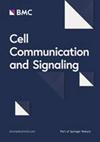巨噬细胞源性外泌体通过传递 miR-155 促进肾小管上皮细胞端粒脆性和衰老
IF 8.2
2区 生物学
Q1 CELL BIOLOGY
引用次数: 0
摘要
慢性肾脏病(CKD)在全球范围内发病率很高,给全球造成了巨大的负担,而且这种负担还在不断加重。慢性肾脏病表现出一系列加速衰老的特征。肾小管细胞衰老是导致 CKD 进展的常见生物过程。肾小管间质炎症是肾小管细胞衰老的驱动因素,也是 CKD 的共同特征。然而,间质炎症驱动肾小管细胞衰老的机制仍不清楚。本文旨在探讨源自巨噬细胞的外泌体 miRNA 在肾小管细胞衰老发展过程中的作用。在已确定的炎症相关 miRNA 中,miR-155 被认为是参与炎症反应的最重要 miRNA 之一。巨噬细胞是介导炎症过程的主要免疫细胞,它们释放的外泌体中含有大量的 miR-155。我们评估了 miR-155 在肾小管细胞衰老和肾脏纤维化中的潜在作用。我们将 miR-155-/- 小鼠和野生型对照组以及肾小管上皮细胞(TECs)置于血管紧张素 II(AngII)诱导的肾损伤中。我们使用标准技术评估了肾功能和损伤。对肾小管上皮细胞进行了体内和体外细胞衰老和端粒功能障碍评估。通过荧光原位杂交测量端粒。与正常对照组相比,miR-155在CKD患者和CKD小鼠模型的近端肾小管细胞中上调。此外,miR-155的表达与肾脏纤维化程度、eGFR下降和p16INK4A的表达呈正相关。miR-155 的过表达加剧了肾小管衰老,p16INK4A/p21 表达和衰老相关的 β-半乳糖苷酶活性的增加就是证明。值得注意的是,miR-155 基因敲除可减轻体内肾纤维化和肾小管细胞衰老。有趣的是,巨噬细胞衍生的miR-155外泌体一旦释放,就会被TECs内化,通过靶向TRF1导致端粒缩短和功能障碍。双荧光素酶报告实验证实,TRF1是miR-155的直接靶标。因此,我们的研究清楚地表明,外泌体miR-155可能介导巨噬细胞和TEC之间的交流,进而诱导TEC的端粒功能障碍和衰老。我们的研究提示了一种新的机制,即巨噬细胞外泌体参与了肾小管衰老和肾脏纤维化的发展,部分原因是通过传递miR-155靶向TRF1促进端粒功能障碍。我们的研究可能会为治疗 AngII 引起的肾损伤提供新的策略。本文章由计算机程序翻译,如有差异,请以英文原文为准。
Macrophage-derived exosomes promote telomere fragility and senescence in tubular epithelial cells by delivering miR-155
Chronic kidney disease (CKD) is highly prevalent worldwide, and its global burden is substantial and growing. CKD displays a number of features of accelerated senescence. Tubular cell senescence is a common biological process that contributes to CKD progression. Tubulointerstitial inflammation is a driver of tubular cell senescence and a common characteristic of CKD. However, the mechanism by which the interstitial inflammation drives tubular cell senescence remains unclear. This paper aims to explore the role of exosomal miRNAs derived from macrophages in the development of tubular cell senescence. Among the identified inflammation-related miRNAs, miR-155 is considered to be one of the most important miRNAs involved in the inflammatory response. Macrophages, the primary immune cells that mediate inflammatory processes, contain a high abundance of miR-155 in their released exosomes. We assessed the potential role of miR-155 in tubular cell senescence and renal fibrosis. We subjected miR-155−/− mice and wild-type controls, as well as tubular epithelial cells (TECs), to angiotensin II (AngII)-induced kidney injury. We assessed kidney function and injury using standard techniques. TECs were evaluated for cell senescence and telomere dysfunction in vivo and in vitro. Telomeres were measured by the fluorescence in situ hybridization. Compared with normal controls, miR-155 was up-regulated in proximal renal tubule cells in CKD patients and mouse models of CKD. Moreover, the expression of miR-155 was positively correlated with the extent of renal fibrosis, eGFR decline and p16INK4A expression. The overexpression of miR-155 exacerbated tubular senescence, evidenced by increased detection of p16INK4A/p21expression and senescence-associated β-galactosidase activity. Notably, miR-155 knockout attenuates renal fibrosis and tubule cell senescence in vivo. Interestingly, once released, macrophages-derived exosomal miR-155 was internalized by TECs, leading to telomere shortening and dysfunction through targeting TRF1. A dual-luciferase reporter assay confirmed that TRF1 was the direct target of miR-155. Thus, our study clearly demonstrates that exosomal miR-155 may mediate communication between macrophages and TECs, subsequently inducing telomere dysfunction and senescence in TECs. Our work suggests a new mechanism by which macrophage exosomes are involved in the development of tubule senescence and renal fibrosis, in part by delivering miR-155 to target TRF1 to promote telomere dysfunction. Our study may provide novel strategies for the treatment of AngII-induced kidney injury.
求助全文
通过发布文献求助,成功后即可免费获取论文全文。
去求助
来源期刊

Cell Communication and Signaling
CELL BIOLOGY-
CiteScore
11.00
自引率
0.00%
发文量
180
期刊介绍:
Cell Communication and Signaling (CCS) is a peer-reviewed, open-access scientific journal that focuses on cellular signaling pathways in both normal and pathological conditions. It publishes original research, reviews, and commentaries, welcoming studies that utilize molecular, morphological, biochemical, structural, and cell biology approaches. CCS also encourages interdisciplinary work and innovative models, including in silico, in vitro, and in vivo approaches, to facilitate investigations of cell signaling pathways, networks, and behavior.
Starting from January 2019, CCS is proud to announce its affiliation with the International Cell Death Society. The journal now encourages submissions covering all aspects of cell death, including apoptotic and non-apoptotic mechanisms, cell death in model systems, autophagy, clearance of dying cells, and the immunological and pathological consequences of dying cells in the tissue microenvironment.
 求助内容:
求助内容: 应助结果提醒方式:
应助结果提醒方式:


